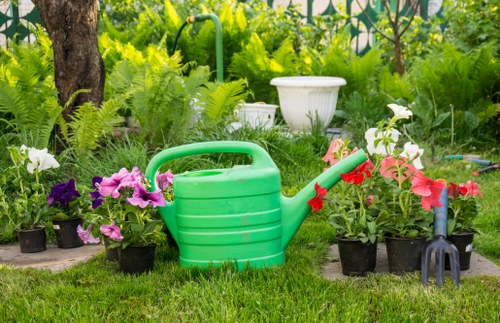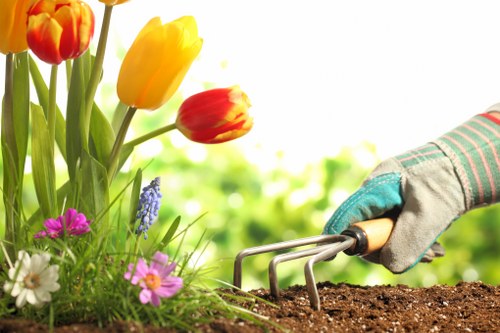Comprehensive Guide to Garden Maintenance in Covent Garden

Introduction to Garden Maintenance
Maintaining a garden in Covent Garden requires a blend of creativity, dedication, and knowledge of local horticultural practices. Whether you have a sprawling backyard or a compact urban garden, proper maintenance ensures your plants thrive and your outdoor space remains beautiful throughout the year.
Appropriate garden maintenance not only enhances the aesthetic appeal of your property but also contributes to the overall health of the ecosystem. By implementing effective techniques, you can create a vibrant and sustainable garden that serves as a peaceful retreat in the bustling heart of Covent Garden.
In this article, we'll explore essential garden maintenance strategies tailored to the unique climate and urban setting of Covent Garden, providing you with the tools and knowledge to cultivate a stunning garden.

Understanding the Covent Garden Climate
Local Climate Conditions
Covent Garden, located in the heart of London, experiences a temperate maritime climate. This means mild summers, cool winters, and precipitation spread throughout the year. Understanding these conditions is crucial for selecting the right plants and scheduling maintenance activities effectively.
The region receives an average annual rainfall of around 600mm, which influences the types of vegetation that can flourish. Additionally, urban microclimates created by surrounding buildings and pavements can affect temperature and humidity levels, making it essential to choose plants that can adapt to these variations.
By taking into account the specific climate patterns of Covent Garden, gardeners can make informed decisions that promote plant health and garden sustainability.

Essential Garden Maintenance Practices
Regular Weeding
Weeding is a fundamental aspect of garden maintenance. Regular removal of unwanted plants prevents competition for nutrients, water, and light, allowing your desired plants to thrive. In Covent Garden's urban environment, managing weeds can be particularly challenging due to limited space and the potential for invasive species.
Tools for Effective Weeding
- Hand Trowel
- Weeding Fork
- Mulching Materials
Using the right tools and techniques can make weeding less labor-intensive and more efficient.
Pruning and Trimming
Pruning helps maintain the shape and size of plants, encourages healthy growth, and removes dead or diseased branches. Proper pruning techniques are essential to avoid damaging plants and to promote their longevity.
When to Prune
- Early Spring for most deciduous plants
- After flowering for shrubs and perennials
- Year-round for evergreen plants as needed
Understanding the optimal times for pruning ensures that plants recover quickly and continue to grow robustly.
Watering Techniques
Adequate watering is vital for plant health, but overwatering can lead to root rot and other issues. In Covent Garden, the temperate climate usually provides sufficient rainfall, but supplemental watering may be necessary during dry spells.
Best Practices for Watering
- Water early in the morning to reduce evaporation
- Use drip irrigation systems for efficient water use
- Check soil moisture regularly
Implementing these practices helps maintain optimal soil moisture levels without wasting water.

Seasonal Garden Maintenance Tips
Spring Maintenance
Spring is the perfect time to prepare your garden for the growing season. Begin by clearing out any debris left over from winter and inspecting plants for damage. Plant new flowers, vegetables, and herbs to add color and freshness to your garden.
Essential Spring Tasks
- Soil Testing and Amendment
- Planting Perennials and Annuals
- Setting Up Mulch Beds
These tasks help create a strong foundation for your garden’s growth throughout the year.
Summer Care
During the summer months, focus on maintaining consistent watering schedules and protecting plants from excessive heat. Regularly harvesting vegetables and flowers can encourage more growth and keep your garden productive.
Summer Maintenance Tips
- Implement Shade Solutions for Sensitive Plants
- Regular Deadheading to Promote Blooms
- Monitor for Pests and Diseases
Proactive summer care ensures that your garden remains vibrant and healthy despite the challenges of warmer weather.
Autumn Preparations
As temperatures begin to drop, prepare your garden for the colder months by cleaning up fallen leaves and dead plant material. This is also an ideal time to plant bulbs for spring blooms and to protect perennials from frost.
Autumn Tasks
- Composting Organic Waste
- Planting Bulbs and Cover Crops
- Applying Protective Mulch
These steps help ensure that your garden transitions smoothly into winter and is ready to flourish again in the spring.
Winter Maintenance
Winter gardening focuses on protecting plants from frost and reducing garden activity to prevent damage. Use covers and mulch to insulate plants and minimize exposure to harsh weather conditions.
Winter Care Strategies
- Pruning Dormant Trees and Shrubs
- Maintaining Garden Equipment
- Planning for the Next Growing Season
Effective winter maintenance keeps your garden healthy and ready for rebirth when warmer weather returns.

Choosing the Right Plants for Covent Garden Gardens
Perennials vs. Annuals
Selecting the appropriate plants is crucial for successful garden maintenance. Perennials offer long-term beauty and require less frequent replanting, while annuals provide vibrant colors and variety but need to be replanted each year.
Benefits of Perennials
- Low Maintenance
- Year-Round Structure
- Cost-Effective in the Long Run
These plants are ideal for creating a stable and enduring garden framework.
Vegetable and Herb Gardens
Incorporating vegetables and herbs into your garden can provide fresh produce and add culinary delights to your kitchen. Choose varieties that thrive in Covent Garden’s climate and ensure they receive adequate sunlight and nutrients.
Popular Choices
- Tomatoes
- Basil
- Spinach
These plants are not only easy to grow but also highly rewarding for both novice and experienced gardeners.
Shade-Tolerant Plants
Given the urban shading from buildings in Covent Garden, it’s important to select plants that can thrive in low-light conditions. Shade-tolerant plants can add greenery and color to areas that receive limited sunlight.
Top Shade Plants
- Hostas
- Ferns
- Impatiens
These plants can brighten up shaded spaces and add diversity to your garden’s foliage.
Native Plants
Using native plants in your garden supports local biodiversity and requires less maintenance, as these species are adapted to the local climate and soil conditions.
Advantages of Native Plants
- Resilient to Local Pests and Diseases
- Require Less Water and Fertilizer
- Support Local Wildlife
Integrating native species can create a sustainable and eco-friendly garden environment.
Tools and Equipment for Effective Garden Maintenance
Having the right tools is essential for efficient garden maintenance. Investing in quality equipment can make tasks easier and more enjoyable.
Basic Garden Tools
- Hand Trowel
- Pruning Shears
- Garden Fork
- Watering Can or Hose
- Gloves
These tools form the foundation of any gardener’s toolkit, facilitating various maintenance tasks from planting to pruning.
Advanced Equipment
For larger gardens or more intensive maintenance, consider investing in advanced tools such as:
- Lawn Mower
- Electric or Gas Trimmers
- Power Pruners
- Soil Aerators
These tools can significantly enhance your maintenance efficiency and help achieve professional-looking results.
Maintenance of Tools
Proper maintenance of garden tools extends their lifespan and ensures they perform effectively. Regular cleaning, sharpening, and storage are key practices.
Tool Care Tips
- Clean tools after each use to prevent rust and corrosion
- Sharpen blades regularly for optimal performance
- Store tools in a dry, sheltered area
Maintaining your tools in good condition reduces the need for frequent replacements and keeps your garden maintenance tasks running smoothly.
Eco-Friendly Tools
Consider using eco-friendly tools and equipment to minimize your garden’s environmental impact. Solar-powered lights, rainwater collection systems, and composting bins are excellent additions.
Benefits of Eco-Friendly Tools
- Reduce Energy Consumption
- Promote Sustainable Practices
- Enhance Garden Health
Implementing these tools supports a greener, more sustainable gardening approach.
Digital Tools and Apps
Modern technology offers various digital tools and apps to aid in garden maintenance. These can help with scheduling, plant identification, and pest management.
Popular Gardening Apps
- Garden Planner
- PlantSnap
- Pest Identifier
Utilizing these tools can streamline your maintenance routine and provide valuable insights for optimal garden care.
Pest and Disease Management
Maintaining a healthy garden involves managing pests and diseases that can harm your plants. Implementing integrated pest management (IPM) strategies helps control infestations while minimizing environmental impact.
Identifying Common Pests
- Aphids
- Slugs and Snails
- Japanese Beetles
- Spider Mites
Early identification of pests allows for prompt and effective treatment, preventing widespread damage.
Natural Pest Control Methods
Using natural predators and organic treatments can effectively manage pests without harmful chemicals. Encouraging beneficial insects like ladybugs and praying mantises can help keep pest populations in check.
Organic Solutions
- Neem Oil Sprays
- Insecticidal Soaps
- Bacillus thuringiensis (Bt)
These organic treatments offer safe and environmentally friendly options for pest control.
Disease Prevention
Preventing plant diseases involves maintaining proper hygiene, ensuring good air circulation, and selecting disease-resistant plant varieties.
Key Practices
- Remove and dispose of infected plant material
- Water plants at the base to keep foliage dry
- Rotate crops to prevent soil-borne diseases
Implementing these practices reduces the risk of disease outbreak and promotes overall plant health.
Chemical Controls
When natural methods are insufficient, judicious use of chemical pesticides may be necessary. Always follow label instructions and consider the environmental impact before application.
Safe Usage Tips
- Use targeted treatments to minimize non-target effects
- Apply pesticides during optimal weather conditions
- Store chemicals securely away from children and pets
Responsible use of chemical controls ensures effective pest management while safeguarding your garden’s ecosystem.
Monitoring and Maintenance
Regularly inspecting your garden for signs of pests and diseases allows for timely interventions. Keeping a maintenance log can help track issues and identify patterns over time.
Effective Monitoring Techniques
- Visual Inspections
- Setting Up Traps
- Using Protective Barriers
Consistent monitoring is key to maintaining a healthy and resilient garden.
Creating a Sustainable Garden
Sustainability in garden maintenance ensures long-term health and productivity while minimizing environmental impact. Incorporating eco-friendly practices preserves resources and supports local ecosystems.
Composting
Composting transforms organic waste into nutrient-rich soil amendments, enhancing soil structure and fertility. It reduces the need for chemical fertilizers and promotes a closed-loop garden ecosystem.
How to Start Composting
- Choose a Compost Bin Location
- Balance Green and Brown Materials
- Maintain Moisture and Aeration
Starting a compost system is straightforward and offers significant benefits for your garden’s health.
Rainwater Harvesting
Collecting rainwater reduces reliance on municipal water sources and provides plants with natural, chemical-free hydration. Installing rain barrels or other collection systems is a simple way to implement this practice.
Rainwater Collection Tips
- Position Barrels to Capture Maximum Rainfall
- Use Gutter Guards to Prevent Debris
- Store Water Safely to Prevent Mosquito Breeding
Harvesting rainwater supports sustainable watering practices and conserves valuable resources.
Using Native and Drought-Resistant Plants
Choosing native and drought-resistant plants reduces water usage and supports local wildlife. These plants are adapted to the local climate, requiring less maintenance and resources.
Top Sustainable Plant Choices
- Lavender
- Sedum
- Shasta Daisy
Incorporating these plants fosters a resilient and eco-friendly garden environment.
Mulching
Applying mulch conserves soil moisture, suppresses weeds, and regulates soil temperature. Organic mulches like bark, straw, and compost enrich the soil as they decompose.
Benefits of Mulching
- Reduces Water Evaporation
- Prevents Weed Growth
- Improves Soil Health
Mulching is a simple yet effective practice for enhancing garden sustainability.
Energy-Efficient Lighting
Incorporating energy-efficient lighting, such as LED or solar-powered lights, illuminates your garden while reducing energy consumption. Proper lighting can highlight garden features and extend outdoor enjoyment into the evening hours.
Lighting Installation Tips
- Choose Sustainable Light Sources
- Position Lights Strategically for Maximum Effect
- Use Timers and Sensors to Optimize Usage
Energy-efficient lighting enhances both the functionality and beauty of your garden.
Reducing Chemical Use
Minimizing the use of chemical fertilizers and pesticides promotes a healthier garden ecosystem. Opt for organic alternatives and natural remedies to maintain plant health without compromising the environment.
Eco-Friendly Alternatives
- Use Compost or Manure as Fertilizers
- Implement Biological Pest Control
- Adopt Integrated Pest Management (IPM) Practices
Reducing chemical use supports sustainable gardening and protects beneficial insects and soil organisms.
Encouraging Biodiversity
A diverse garden attracts a variety of pollinators and beneficial insects, contributing to a balanced ecosystem. Planting a mix of flowering plants, shrubs, and trees creates habitats that support wildlife and enhance garden resilience.
Ways to Promote Biodiversity
- Plant a Variety of Species
- Provide Shelter and Nesting Sites
- Maintain Natural Water Sources
Enhancing biodiversity strengthens your garden’s health and beauty, making it a vibrant part of Covent Garden’s urban landscape.
Hiring Professional Garden Maintenance Services
While DIY garden maintenance is achievable, professional services can offer expertise and efficiency, especially for complex or large-scale gardens. Hiring local garden maintenance professionals in Covent Garden ensures that your garden receives tailored care that aligns with your vision and local conditions.
Benefits of Professional Services
- Expert Knowledge of Local Plants and Climate
- Access to Specialized Tools and Equipment
- Time-Saving and Convenient
Professionals can provide comprehensive care, from routine maintenance to specialized landscaping projects.
Choosing the Right Service Provider
Selecting a reliable garden maintenance service involves evaluating their experience, expertise, and reputation. Look for providers who understand the unique challenges of gardening in an urban setting like Covent Garden.
Factors to Consider
- Experience and Expertise
- Customer Reviews and Testimonials
- Range of Services Offered
Thorough research ensures you choose a service that meets your specific garden maintenance needs.
Services Offered by Professionals
Comprehensive Maintenance
Includes regular weeding, pruning, fertilizing, and pest control to keep your garden in top condition year-round.
Landscaping and Design
Professionals can assist with garden design, plant selection, and landscape enhancements to create a personalized outdoor space.
Seasonal Services
Offering specialized services tailored to each season ensures that your garden receives the appropriate care at the right time.
Cost Considerations
Understanding the costs associated with professional garden maintenance helps in budgeting and finding services that offer good value for money.
Pricing Structures
- Hourly Rates
- Fixed Packages
- Custom Quotes
Compare different pricing models to find one that aligns with your budget and maintenance needs.
Local Expertise
Local garden maintenance services possess in-depth knowledge of Covent Garden’s specific environmental conditions, plant varieties, and regulatory requirements, ensuring compliant and effective garden care.
Advantages of Local Services
- Familiarity with Local Pests and Diseases
- Knowledge of Suitable Plant Species
- Responsive and Personalized Service
Choosing a local provider supports the community and ensures your garden is maintained by experts who understand the area.
Customer Satisfaction
Professional services prioritize customer satisfaction by delivering quality work, adhering to schedules, and maintaining clear communication. Satisfied customers often lead to repeat business and positive referrals.
Ensuring Quality Service
- Read Reviews and Ask for References
- Request Detailed Quotes and Service Agreements
- Communicate Your Expectations Clearly
Taking these steps helps ensure that you receive reliable and high-quality garden maintenance services.
Custom Maintenance Plans
Tailored maintenance plans address the specific needs of your garden, taking into account factors like plant types, garden size, and personal preferences. Custom plans provide personalized care that aligns with your gardening goals.
Creating a Custom Plan
- Assess Your Garden’s Needs
- Set Clear Objectives
- Collaborate with Professionals to Develop the Plan
A personalized maintenance plan ensures that your garden receives the appropriate level of care and attention throughout the year.
Conclusion
Effective garden maintenance in Covent Garden involves a combination of understanding local climate conditions, implementing essential maintenance practices, and making sustainable choices that benefit both your garden and the environment. Whether you choose to maintain your garden yourself or hire professional services, prioritizing regular care and thoughtful planning will result in a beautiful and thriving outdoor space.
Embrace the beauty of Covent Garden by investing time and resources into maintaining your garden, creating a serene oasis amidst the urban landscape.
Contact us today to learn more about our garden maintenance services and start transforming your garden into a stunning retreat.